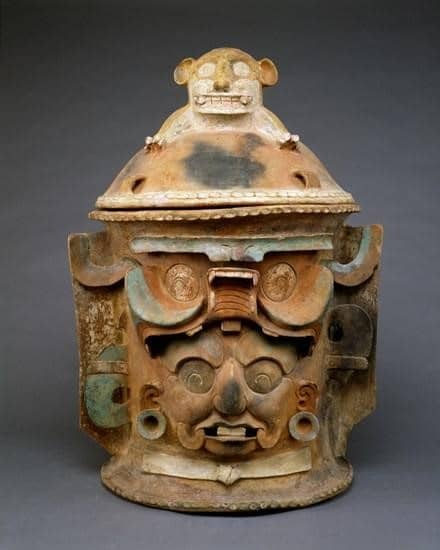Funerals and associated ceremonies have always played a significant part of human history. Different cultures held different beliefs and as such engaged in varied cultural and social rituals. The Mayans for example, are renowned for their artistic expressions that involved the use of urns to burry prominent individuals within society. These ceramic urns were highly artistic and often were shaped to represent the character of the individual whose remains they would contain. They could also represent socially and culturally revered figures and images. One such urn is the Funerary urn with Feline Lid, found in The Museum of Fine Arts, Houston. The piece of art presents a significant part of ancient Mayan history, with precise emphasis on funeral practices. It also does draw attention to the deity nature of felines within the culture, as well as their role in the afterlife. This research analyzes the Funerary urn with Feline Lid with the aim of understanding its artistic and cultural representation.
The Funerary urn with Feline Lid, is of unknown origins with no specific artist attributed. However, archeological studies reveal that it is of Mayan origins with archelogical estimates reveal that it was created between 600 AD and 900 AD. The urn was first discovered in the 1970s and was owned by several parties before finally falling into the hands of The Museum of Fine Arts, Houston. Since 1993, this piece of work has been on display at various art galleries and museums, on hire or loan from The Museum of Fine Arts, Houston.
This and other similar urns were often found buried in and around sacred sites such as pyramids and caves. The nature of the art found on the urns could thus have a religious aspect to them. Any animal and figures scripted/ curve or engraved on the urns bore some religious meaning to the Mayans. On the body of the urn, there is an image of what could be perceived as the face of a great ancestor or deity. This is essentially the same form found on the burial urn presented in The Walters Art Museum. On the form, The Walters Art Museum states, “This deity/ancestor combines features of K’inich Ajaw (the sun god) and GI, a patron god at Palenque, Mexico. He emerges from the open maw of the xoc (shark) saurian, which symbolizes the watery underworld, the deified personage ready to interact with his prayerful descendants”. This clearly shows the patronage nature of the Mayan society and reverence for death.
We can do it today.
The urn is “earthenware with slip and traces pf polychrome pigment”. It seems that the Mayans not only took time to mold the pieces of art into desired shape, but also applied meticulous skill to paint them with varied colors. From the images available Funerary urn with Feline Lid, has at least three visible colors painted on it; black, teal and white. The rest of the urn has a brown-earthenware color. The colors and shapes certainly represent the image of particular deities that the souls of the dead would reincarnate to. The urns could thus be deemed to be vessels that help carry the soul into the spirit would. This could also exlpain the reason why such urns are found on sites with religious significance.
The most spectacular part of the urn is the lid that has the curving of a feline. This is both an artistic and cultural significant aspect that is presented on the urn. According to Saunders, the Mayans highly revered felines, and especially the jaguar, thus the reason why they were so common on religious artifacts. On the jaguar, Saunders writes, “The power of the jaguar is such that its supreme form, i.e as shaman, appears to be regarded as omnipotent in ritual as its physical form is in the natural world”. As such the appearance of the feline form on what can be considered to be sacred artifacts is no surprise. Its placement on top of the urn could also be intentional, rather than artistic. Cultural beliefs were such that the soul ascends to the sky. As a consequence, having a feline figure on the urn, could help and aid with the assention. It could also help wade bad spirits ensuring that the dead individual achieves deity-hood.

A review of the piece of art clearly outlines the cultural and artistic nature of the Mayan society. The urn bears both religious and social markings that help bring an understanding into the Mayan culture in the period within which it was created. It thus is one of the most educative pieces of art that I personally have come across.
Image of artifact chosen

Retrieved from The Museum of Fine Arts, Houston, https://www.mfah.org/art/detail/24929?returnUrl=%2Fart%2Fsearch%3Fculture%3DMaya%26page%3D4
- Maya. Funerary Urn with Feline Lid. 2 December 2017 <https://www.mfah.org/art/detail/24929?returnUrl=%2Fart%2Fsearch%3Fculture%3DMaya%26page%3D4>
- McCampbell, Kathleen Garrett. “Highland Maya Effigy Funerary Urns: A Study of Genre, Iconography, and Function.” 2010. Florida State University Libraries. 3 December 2017 <http://diginole.lib.fsu.edu/islandora/object/fsu%3A180888>.
- Saunders, Nicholas J. Icons of Power: Feline Symbolism in the Americas. Abingdon, United Kingdom: Psychology Press, 1998.
- The Walters Art Museum. Burial Urn. 2 December 2017 <http://art.thewalters.org/detail/80196/burial-urn/>.
